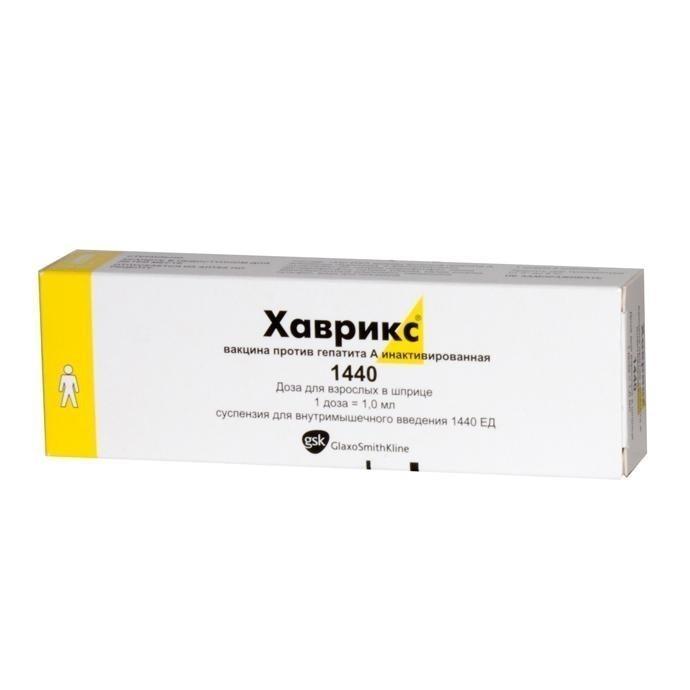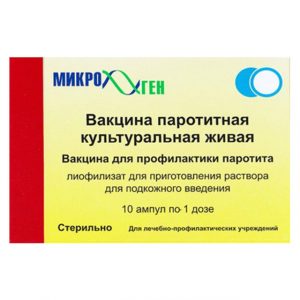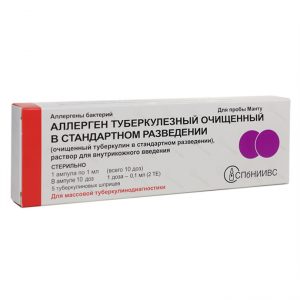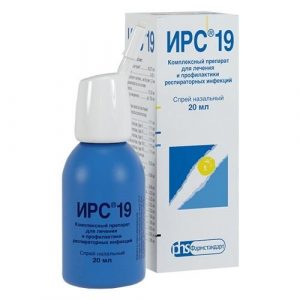Description
Release form
Intramuscular suspension for adults
Packaging
syringe 1 ml.
Pharmacological action of
The Havrix vaccine provides protection against hepatitis A by forming specific immunity by inducing the production of antibodies against hepatitis A virus (HAV), as well as the activation of cellular immunity mechanisms.
Clinical studies have shown that seroprotection (> 20 mIU / ml) is achieved in 99% of those vaccinated 30 days after the first dose. The data obtained when the vaccine was administered twice with an interval of 6-12 months, we can conclude that 97% of the vaccinated 25 years after the course will have a protective antibody titer (> 20 mIU / ml).
When studying the kinetics of the immune response, it was found that after administration of a single dose of the Havrix vaccine, seroprotection is achieved on day 13 in 79% of vaccinees, on day 15 in 86.3%, and on 17- day in 95.2% day 1, and 99% – on day 19, i.e. these time intervals are shorter than the average incubation period for hepatitis A (4 weeks).
The efficacy of the Havrix vaccine was evaluated during outbreaks of disease affecting large populations (Alaska, Slovakia, USA, Great Britain, Israel, Italy), as well as in family centers and organized children’s groups. These studies showed that Havrix vaccination led to the cessation of outbreaks. With vaccine coverage of at least 80% of the susceptible population, relief of the outbreak is achieved within 4-8 weeks.
To ensure long-term protection, a second (booster) dose should be administered between 6 and 12 months. after the first dose. It was found that revaccination carried out in the period up to 12-60 months after vaccination induces the production of the same level of antibodies as revaccination carried out after 6-12 months. after vaccination.
Based on the available data, it can be concluded that persons with unchanged immune status after a two-dose vaccination course, there is no need to carry out additional revaccination.
Indications
Prevention of hepatitis A from 12 months of age.
Contraindications
Hypersensitivity to any component of the vaccine hypersensitivity symptoms to previous administration of the Havrix vaccine.
Acute infectious and non-infectious diseases, exacerbation of chronic diseases are temporary contraindications for vaccinations in mild acute respiratory viral infections, acute intestinal diseases vaccinations are carried out immediately after normalization of temperature.
Use during pregnancy and lactation
Due to the lack of adequate data on the use of the vaccine during pregnancy and lactation, it is not recommended to administer Havriks to pregnant and lactating women, despite the minimal risk of exposure of the inactivated vaccines to the fetus and child.
Havriks during pregnancy and lactation should be used only if there are absolute indications.
Special instructions
In regions with low or moderate hepatitis A endemicity, Havrix vaccination is especially recommended for people with an increased risk of infection, for people with hepatitis A who may have a severe course or for people who have hepatitis A because of their professional affiliation may cause outbreaks. These include:
persons traveling to hyperendemic regions or regions, where hepatitis A outbreaks are recorded Travelers:
Military personnel: military personnel deployed in areas with poor sanitary conditions or unwarranted water supplies.
Persons whose hepatitis A disease due to their professional affiliation can lead to outbreaks of
and for whom there is a professional risk of hepatitis A virus infection: school and kindergarten staff, nurses and nurses, especially in infectious, gastroenterological and pediatric medical treatment -professional institutions, workers of sewage systems and water treatment facilities, workers of catering and food industry – product new warehouses, personnel of closed institutions of the GUIN system, social security and medical institutions.
Persons living or in the foci of hepatitis A, including family, or living in areas where outbreaks are recorded.
People with a behavioral risk of getting hepatitis A virus: homosexuals, people who have hectic sex lives, drug addicts who inject drugs.
Patients suffering from hemophilia
Persons who have household contact with an infected person. Virus isolation can occur for quite some time. In this regard, vaccination is recommended for all persons in contact with the infected.
Populations with a known high incidence of hepatitis A or populations in which the incidence of hepatitis A is elevated due to poor hygiene conditions.
Persons with chronic liver disease or an increased risk of liver disease (chronic carriers of hepatitis B, C viruses, delta, people suffering from chronic hepatitis of alcoholic, autoimmune, toxic, drug and other genesis, persons with Wilson-Konovalov ² ¢s disease, hepatoses and hepatopathies).
In regions of moderate or high endemicity, hepatitis A vaccination is recommended for all susceptible populations.
Composition of
1 ml of the vaccine contains 1440 ELISA units of hepatitis A virus antigen
excipients:
Aluminum hydroxide – 0.5 mg (sorbent),
2-phenoxyethanol – 5 mg (preservative),
mixture of amino acids,
, sodium hydrophosphate,
, sodium hydrophosphate,
potassium dihydrogen phosphate,
polysorbate 20,
potassium chloride,
sodium chloride,
neomycin sulfate (traces),
water for injection.
Dosage and administration
The havrix vaccine is intended for intramuscular administration.
Adults and older children should be given the vaccine in the deltoid region, and in children 12-24 months old, in the anterolateral region of the thigh.
The vaccine should not be injected into the gluteus muscle, as well as subcutaneously, since with such routes of administration, the formation of antibodies to hepatitis A virus may not reach the optimal level.
Vaccination regimens
The single dose for primary vaccination for adults and adolescents over 16 years old is 1.0 ml, for children and adolescents under 16 years old – 0.5 ml.
Revaccination is carried out 6-12 months after vaccination, using a dosage of the drug that is appropriate for age.
The optimal interval between vaccinations is 6-12 months. The booster (booster) effect is achieved with the introduction of a booster dose and in the period 12-60 months after the introduction of the vaccination dose.
Side effects
The Hawriks vaccine is usually well tolerated.
Local reactions may develop: short-term pain at the injection site was rated as severe at less than 0, 5% of cases) redness and swelling, the frequency of which was about 4% of the total number of vaccinations.
General reactions are mostly mild, with most of them lasting no more than 24 hours. General reactions are manifested by headache, malaise, vomiting, fever, nausea, and loss of appetite. The frequency of these phenomena ranged from 0.8% to 12.8% of the total number of vaccinations. All these undesirable phenomena took place without consequences.
The nature of the adverse reactions and symptoms in children was the same as in adults, but their adverse reactions were observed with less frequency. During post-registration observations, rare occurrences such as fatigue, diarrhea, myalgia, arthralgia, allergic reactions, including anaphylactoid reactions, as well as seizures.
Drug Interactions
The Havrix vaccine can be administered simultaneously with inactivated vaccines of the national calendar for vaccination vaccines of the Russian Federation and the vaccination calendar for epidemiological indications of the Russian Federation.
When administered simultaneously with inactivated vaccines against typhoid fever, cholera, tetanus, and yellow fever, a decrease in the immune response to the Havrix vaccine was not observed.
When administered simultaneously with human immunoglobulins, the protective effect of the vaccine is not reduced.
If it becomes necessary to administer Havriks with other vaccines or with immunoglobulins, then the drugs are administered using different syringes and needles to different parts of the body.
Storage conditions
The vaccine should be stored and transported at +2 to + 8 ° C.
Do not freeze! In case of freezing, the use of the vaccine is not allowed.
Deystvuyuschee substances
vaccine for the prevention of viral hepatitis A
Form of Treatment
suspension dlya inaektsiy




